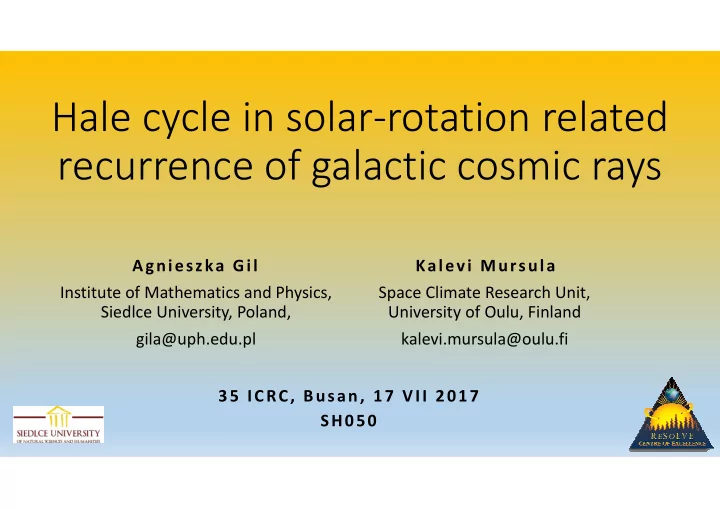

Hale cycle in solar-rotation related recurrence of galactic cosmic rays Agnieszka Gil Kalevi Mursula Institute of Mathematics and Physics, Space Climate Research Unit, Siedlce University, Poland, University of Oulu, Finland gila@uph.edu.pl kalevi.mursula@oulu.fi 35 ICRC, Busan, 17 VII 2017 SH050
Outline Abstract The Hale cycle consisting of two successive 11-year solar activity cycles Recurrent galactic cosmic rays variation during last fifty years Polarity dependence Declining trend Conclusions
We study the long-term change of the amplitude of the first ( A 27) and second ( A 14) harmonics of GCR recurrent variation connected to the solar rotation period. Using two high-latitude neutron monitors, Oulu and Apatity, we verify the dominant 11-year cycle in A 27 and A 14 and their systematic 22-year variation (Hale cycle) during sunspot minima, with higher values during A > 0 polarity minima than during A< 0 (Richardson et al., 1999; Gil & Alania, 2001). We show that the A 27 and A 14 amplitudes during sunspot minima exhibit a slight declining trend. We suggest that this declining trend is due to the weakening of the solar polar magnetic field during the previous four solar cycles and the ensuing latitudinal widening of the HCS region. Amplitudes of the 22-year variation are typically about 15-30 % for A 27 and about 30-45% for A 14. Finally, we give a physical explanation of the observed phase of the 22-year cyclicity in A 14 and A 27.
7000 400 SSN Oulu [count rates] 350 6500 300 6000 250 A<0 A>0 5500 200 5000 150 4500 100 4000 50 3500 0 1964 1974 1984 1994 2004 2014 27-days averaged data of the GCR by Oulu NM (cut-off rigidity 0.8 GV, source: cosmicrays.oulu.fi) and sunspot number (source: omniweb.gsfc.nasa.gov) during 1964 -2017
A>0 A<0
Three-year running means of yearly averaged amplitudes of the first harmonic of GCR recurrence for Oulu and Apatity NMs in 1964-2017. A > 0 epochs marked green and A < 0 orange Daily data from pgia.ru and cosmicrays.oulu.fi
Three-year running means of yearly averaged amplitudes of the second harmonic of GCR recurrence for Oulu and Apatity NMs in 1964-2017. A > 0 epochs marked green and A < 0 orange
Three-year means of amplitude of the first harmonic of GCR recurrence for the last five solar minima with linear trend, using Oulu and Apatity NMs.
Detrended three-year means of amplitude of the first harmonic of GCR recurrence for the last five solar minima, for the Oulu and Apatity NMs.
Three-year means of amplitude of the second harmonic of GCR recurrence for the last five solar minima with linear trend, for the Oulu and Apatity NMs.
Detrended three-year means of amplitude of the second harmonic of GCR recurrence for the last five solar minima, for the Oulu and Apatity NMs.
Daily SWs measured by Ulysses during the first (12.1994– 05.1995, left) and the third (05.2007– 11.2007, right) fast latitudinal scan. The black dash- dotted curve illustrates the latitudinal position of the space probe during that time
Directions of convection and drift during A > 0 and A < 0 (adapted from Moraal & Mulder 1985)
200 150 100 50 0 1976 1986 1996 2006 2016 -50 -100 -150 -200 North South The Sun's Polar Field strength by Wilcox Solar Observatory during 1976-2017
Conclusions The observed Hale cycle in the solar-rotation-related variation of GCRs is due to the different drift patterns and different causes of GCR modulation during the two polarity epochs: during A < 0 the HCS plays the dominant role, while during A > 0 the heliolatitudinal change in SW is more important. The mean amplitude of the Hale cycle is about 30–45% of the mean amplitude for A14 and only about 15–30% for A27. The A27 and A14 during the SC minima depict a declining trend, which can be associated with the weakening in the solar polar magnetic fields during the last four SCs. The weakening of polar fields lead to widening of the HCS which is relatively more important for the amplitude of the second harmonic because it is more likely that the Earth is outside the HCS region only once per solar rotation than twice or more often.
Thank you! Acknowledgements Investigators of Apatity and Oulu NMs. Ulysses and SSN data are from http://omniweb.gsfc.nasa.gov. This work was supported by the Center of Excellence ReSoLVE (project No. 272157) and Polish National Science Centre (decision number DEC-2016/22/E/HS5/00406)
Recommend
More recommend